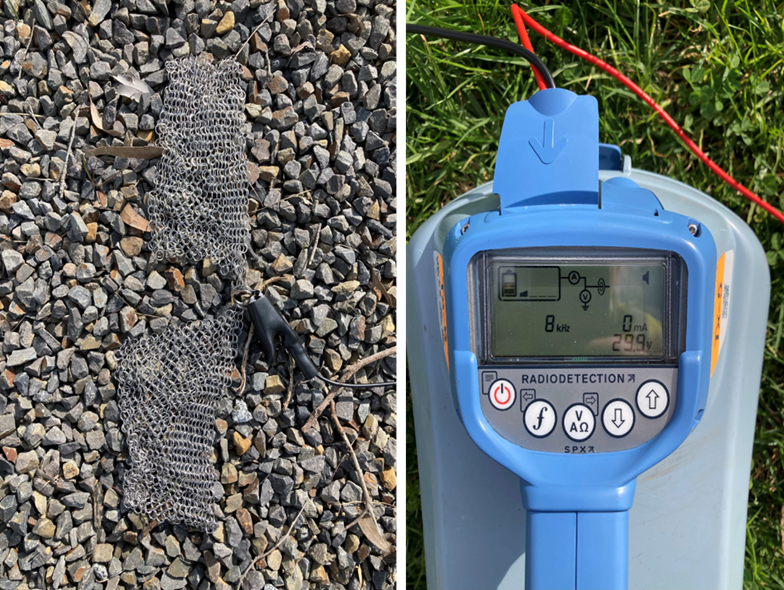By Steve Wood, Senior Trainer and Assessor, CERTLOC
Accurate and reliable locating depends on the strength and quality of the signal transmitted and received along a target asset. In this edition, we examine how the distance of the earth stake from the target asset, the use of earth mats, and the ground conditions affects the resultant current and signal strength. The results are based on testing conducted with a 600mm mild steel water main connected via an electrolysis test point, with the transmitter frequency set at 8 kHz and a signal strength of 10%, while the receiver gain was standardised at 93dB.

Test Scenarios and Results
Scenario 1: Earth Stake at Full Extent of Direct Connect Leads
- Transmitter (Tx): 5mA and 1.3 volts
- Receiver (Rx): 0.93mA and 74.9% signal strength
Placing the earth stake at the full extent of the direct connect leads resulted in strong current flow and excellent signal strength at the receiver.

Scenario 2: Earth Stake 1 Metre from Target Pipe
- Transmitter (Tx): 5mA and 0.9 volts
- Receiver (Rx): 0.39mA and 34.1% signal strength
The earth stake being close to the target asset resulted in reduced current and weaker signal strength resulting also in reduced trace length.

Scenario 3: Single Earth Mat at Full Extent of Direct Connect Leads
- Transmitter (Tx): 2mA and 29.9 volts
- Receiver (Rx): 0.42mA and 35.6% signal strength
Using a single earth mat provides a signal strength but not as good as the earth stake.

Scenario 4: Two Earth Mats at Full Extent of Direct Connect Leads
- Transmitter (Tx): 4mA and 29.9 volts
- Receiver (Rx): 0.78mA and 62.8% signal strength
Doubling the earth mats significantly enhanced the surface area of the ground connection. This led to a considerable improvement in both the current and the signal strength. But still not as good as the earth stake.

Scenario 5: One Earth Mat on Gravel
• Transmitter (Tx): 0mA and 29.9 volts
• Receiver (Rx): No signal detected
Gravel acted as an insulator, preventing effective current flow, and no signal was detected.

Scenario 6: Two Earth Mats on Gravel
- Transmitter (Tx): 0mA and 29.9 volts
- Receiver (Rx): No signal detected
Doubling the earth mats did not overcome the poor conductivity of gravel, reaffirming its limitations as a grounding medium.

Scenario 7: Two Earth Mats on Concrete
- Transmitter (Tx): 1mA and 30 volts
- Receiver (Rx): 0.27mA and 23.2% signal strength
Concrete, while slightly conductive, limited the current flow and resulted in a weak signal.

Scenario 8: Two Earth Mats on Concrete with Water Added
- Transmitter (Tx): 5mA and 2.6 volts
- Receiver (Rx): 0.99mA and 80.5% signal strength
Adding water to the concrete dramatically improved conductivity, resulting in the highest signal strength observed during testing.

Key Conclusions
Distance Matters:
Increasing the distance between the earth connection and the target asset improves current flow and signal strength.
Ground Conductivity Is Critical:
- Poorly conductive materials like gravel severely limit current flow and signal strength.
- Adding moisture significantly enhances ground conductivity, even on less-conductive surfaces like concrete.
Surface Area Impacts Current:
Increasing the surface area of the connection to the ground, such as by using multiple earth mats, improves current and signal strength.
Increased Current:
Greater current flow results in a stronger signal that can travel farther along the target asset, making it easier to locate.
Horizontal vs. Vertical Ground Connections:
A connection to the ground does not need to be vertical. Horizontal configurations, when feasible, can be equally effective.
Adaptability is Key:
Even in challenging environments, such as when an earth stake cannot be inserted into the ground, signals can still be achieved with creative use of mats and moisture.
This study underscores the importance of understanding and optimising ground connections in locating operations. These findings help Certified Locators achieve stronger, more reliable signals, even in challenging conditions, ensuring the accurate identification and mapping of underground assets.
For more insights and technical updates, be sure to look out for the next edition of Technical Tips for Certified Locators.